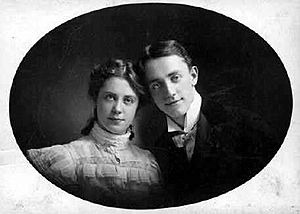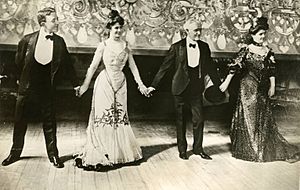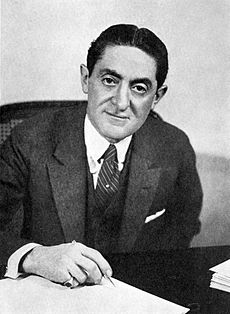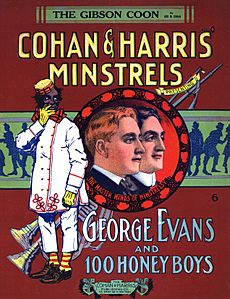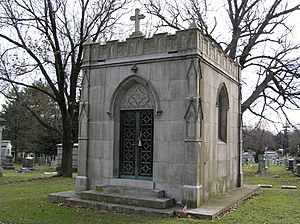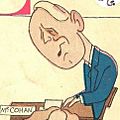George M. Cohan facts for kids
Quick facts for kids
George M. Cohan
|
|
|---|---|
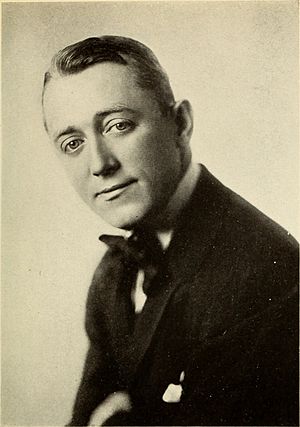
Cohan in 1918
|
|
| Born |
George Michael Cohan
July 3, 1878 |
| Died | November 5, 1942 (aged 64) New York City, US
|
| Occupation |
|
| Spouse(s) |
|
| Children | 4, including Mary and Helen |
George M. Cohan (born July 3, 1878 – died November 5, 1942) was a famous American entertainer. He was a talented playwright, composer, songwriter, actor, singer, dancer, and a theatrical producer (someone who puts on plays and musicals).
Cohan started performing as a child with his parents and sister in a vaudeville act called "The Four Cohans." Vaudeville was a popular type of variety show with different acts like singing, dancing, and comedy. Starting with his show Little Johnny Jones in 1904, he wrote, composed, produced, and acted in more than 36 Broadway musicals.
He wrote over 50 shows and published more than 300 songs during his life. Some of his most famous songs include "Over There", "Give My Regards to Broadway", "The Yankee Doodle Boy", and "You're a Grand Old Flag". He was one of the first members of the American Society of Composers, Authors, and Publishers (ASCAP), a group that protects the rights of songwriters. Cohan kept performing in films until the 1930s and on stage until 1940.
Before World War I, people called him "the man who owned Broadway" because he was so successful and important in American musical comedy. His life and music were shown in the Oscar-winning film Yankee Doodle Dandy (1942) and the 1968 musical George M!. There's even a statue of Cohan in Times Square, New York City, to remember his amazing contributions to American musical theatre.
Contents
Early Life and Family
George M. Cohan was born in 1878 in Providence, Rhode Island. His parents were Irish Catholic and worked as traveling vaudeville performers. Even though his baptism certificate said July 3rd, Cohan and his family always said he was born on the Fourth of July! He joined his parents on stage as a baby, learning to dance and sing as soon as he could walk and talk.
Cohan started performing at age 8, first playing the violin and then dancing. He became the fourth member of "The Four Cohans," which included his father Jeremiah "Jere" Cohan, his mother Helen "Nellie" Cohan, and his sister Josephine "Josie" Cohan. The Four Cohans toured together a lot from 1890 to 1901. George and Josie first performed on Broadway in 1893 in a short play called The Lively Bootblack. When he was young, he could be easily upset, but he learned to control his feelings later. During these early years, he started his famous way of ending a show: "My mother thanks you, my father thanks you, my sister thanks you, and I thank you."
As a child, Cohan and his family traveled most of the year. They spent summer vacations at his grandmother's home in North Brookfield, Massachusetts. There, he became friends with baseball player Connie Mack. The family usually put on a show at the town hall each summer. Cohan got to have more normal childhood experiences, like riding his bike and playing casual baseball games. His happy memories of those summers inspired his 1907 musical 50 Miles from Boston, which takes place in North Brookfield. This show includes one of his most famous songs, "Harrigan". As he grew into his teenage years, he used the quiet summers to write. When he returned to the town in 1934 for a play, he told a reporter, "I've knocked around everywhere, but there's no place like North Brookfield."
Cohan's Career
Early Successes
When he was a teenager, Cohan started writing his own short plays (over 150 of them) and songs for his family's vaudeville act. Soon, he was writing professionally, selling his first songs to a national publisher in 1893. In 1901, he wrote, directed, and produced his first Broadway musical, The Governor's Son, for The Four Cohans. His first big hit on Broadway was the show Little Johnny Jones in 1904. This musical introduced his popular songs "Give My Regards to Broadway" and "The Yankee Doodle Boy".
Cohan became one of the top songwriters in Tin Pan Alley. This was a famous area in New York City where many songwriters and music publishers worked. He published over 300 original songs, known for their catchy tunes and clever words. Some of his major hit songs included:
- "Give My Regards to Broadway"
- "You're a Grand Old Flag"
- "Forty-Five Minutes from Broadway"
- "Mary Is a Grand Old Name"
- "The Warmest Baby in the Bunch"
- "Life's a Funny Proposition After All"
- "I Want To Hear a Yankee Doodle Tune"
- "You Won't Do Any Business if You Haven't Got a Band"
- "The Small Town Gal"
- "I'm Mighty Glad I'm Living, That's All"
- "That Haunting Melody"
- "Always Leave Them Laughing When You Say Goodbye"
- "Over There", which was America's most popular song during World War I. Many artists recorded it, and it was so well-known that a ship was even named "Costigan" after Cohan's grandfather.
From 1904 to 1920, Cohan created and produced over 50 musicals, plays, and revues (shows with songs, dances, and skits) on Broadway with his friend Sam H. Harris. Besides the plays Cohan wrote or composed, he and Harris also produced other successful shows. Many of these were later made into films, like It Pays to Advertise (1914) and Going Up in 1917. At one point, Cohan's shows were running at the same time in as many as five different theaters! One of his most creative plays was the mystery Seven Keys to Baldpate in 1913. It was a big hit and was later made into a film seven times.
In 1925, he wrote his autobiography, Twenty Years on Broadway and the Years It Took to Get There. An autobiography is a book about a person's own life.
Later Career and Films
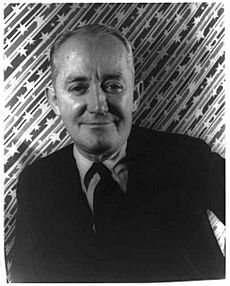
In 1930, Cohan appeared in The Song and Dance Man, a show that honored vaudeville and his father. In 1932, he starred in a Hollywood musical film called The Phantom President, playing two different characters. He had been in some silent films before, but he didn't like how Hollywood made movies. He only made one other sound film, Gambling (1934), which was based on his own play and filmed in New York City. This film is now considered a lost film because copies of it no longer exist.
By the 1930s, Cohan would sometimes retire and then come back to performing. He earned praise as a serious actor in Eugene O'Neill's only comedy Ah, Wilderness! (1933). He also played a song-and-dance version of President Franklin D. Roosevelt in the musical I'd Rather Be Right (1937). His last play, The Return of the Vagabond (1940), featured a young actress named Celeste Holm.
In 1940, Judy Garland starred in a film version of his 1922 musical Little Nellie Kelly. Cohan's mystery play Seven Keys to Baldpate was first filmed in 1916 and has been remade many times. In 1942, a musical movie about Cohan's life, Yankee Doodle Dandy, was released. James Cagney won an Academy Award for Best Actor for playing Cohan in the film. Cohan watched the movie while he was sick with cancer and said about Cagney's performance: "My God, what an act to follow!"
Cohan's Legacy
George M. Cohan is mostly remembered for his songs, but he also helped create the "book musical". This is a type of musical where the songs and dances are part of the story, helping the plot move forward. Cohan used dance not just for show, but to help tell the story, long before others did. His main characters were everyday people, which made them popular with a wide American audience.
In 1914, Cohan helped start ASCAP, an important organization for songwriters. Cohan was known for being generous to other actors who needed help. However, in 1919, he disagreed with a big strike by the Actors' Equity Association, which is the actors' union. Cohan opposed the strike because he was both an actor and a producer, meaning he set the rules for actors' jobs. After the union was recognized, Cohan refused to join it as an actor. This made it harder for him to act in his own shows. He later won a legal case that allowed him to deduct business travel and entertainment costs from his taxes, even if he couldn't show every receipt. This became known as the "Cohan rule" and is still used in tax cases today.
Cohan wrote many Broadway musicals and plays, and he also helped with other shows – over 50 in total! Many of these were made into films. Here are some of his shows:
|
|
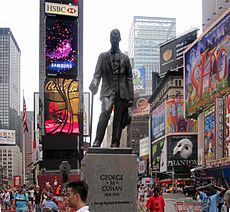
People called Cohan "the greatest single figure the American theatre ever produced" because he was so good as a player, playwright, actor, composer, and producer. On May 1, 1940, President Franklin Delano Roosevelt gave him the Congressional Gold Medal. This was for his help in boosting spirits during World War I, especially with his songs "You're a Grand Old Flag" and "Over There". Cohan was the first person in any artistic field to receive this honor.
In 1959, a bronze statue of Cohan was placed in Times Square, New York City. This 8-foot statue is still the only statue of an actor on Broadway. He was added to the Songwriters Hall of Fame in 1970. His star on the Hollywood Walk of Fame is at 6734 Hollywood Boulevard.
The United States Postal Service released a special stamp honoring Cohan on July 3, 1978, for his 100th birthday. The stamp shows both the older Cohan and his younger self as a dancer, with the words "Yankee Doodle Dandy." On July 3, 2009, a bronze bust (a sculpture of his head and shoulders) of Cohan was put in Fox Point, Providence, near where he was born. The city named the corner the George M. Cohan Plaza.
Personal Life and Death
From 1899 to 1907, Cohan was married to Ethel Levey, an actress and dancer. They had a daughter named Georgette Cohan. Ethel joined The Four Cohans when Josie got married, and she starred in Little Johnny Jones. In 1907, Ethel and Cohan divorced.
In 1908, Cohan married Agnes Mary Nolan, who had been a dancer in his early shows. They stayed married until he died. They had two daughters and a son. Their oldest daughter, Mary Cohan Ronkin, was a singer and even wrote music for her father's play The Tavern. Their second daughter, Helen Cohan Carola, was a film actress. Their youngest child was George Michael Cohan, Jr. He later performed his father's songs on recordings and TV shows. Cohan was a big baseball fan and often watched games of the New York Giants.
George M. Cohan died of cancer at age 64 on November 5, 1942, in his apartment in Manhattan. His funeral was held at St. Patrick's Cathedral in New York City, and thousands of people attended. Many important figures were there, including governors and mayors. Cohan was buried at Woodlawn Cemetery in The Bronx, New York City, in a private family mausoleum he had built earlier for his sister and parents.
Filmography
Cohan acted in the following films:
| Year | Title | Role | Notes |
|---|---|---|---|
| 1917 | Broadway Jones | Broadway Jones | First film role |
| Seven Keys to Baldpate | George Washington Magee | ||
| 1918 | Hit-The-Trail Holliday | Billie Holiday | |
| 1932 | The Phantom President | Theodore K. Blair/Peeter J. 'Doc' Varney | |
| 1934 | Gambling | Al Draper | Last film role |
Gallery
See also
 In Spanish: George M. Cohan para niños
In Spanish: George M. Cohan para niños


